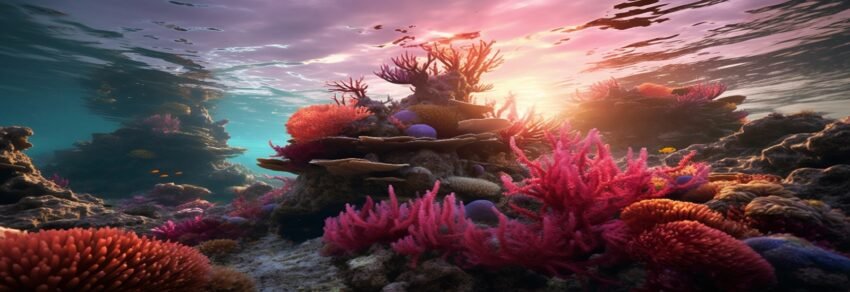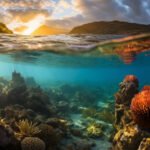Introduction
A coral reef is an underwater ecosystem characterized by reef-building corals. Reefs are made up of
coral polyps held together by calcium carbonate. Cnidaria, which includes corals, sea anemones, and
jellyfish, belongs to the class Anthozoa. Unlike sea anemones, corals secrete hard carbonate
exoskeletons that support and protect the coral reef. Most reefs grow best in warm, shallow, clear
sunny and disturbed water. Coral reefs first appeared 485 million years ago.
Sometimes called the rainforests of the sea, shallow coral reefs comprise some of the most diverse
ecosystems on Earth. They occupy less than 0.1% of the world’s oceans, half the area of France, but they
provide home to at least 25% of all marine species, including fish and molluscs. , worms, crustaceans,
echinoderms, sponges, tunicates and other cnidarians. Coral reefs grow in ocean water, which provides
few nutrients. They are common at shallow depths in tropical waters, but deep-water and cold-water
corals exist on smaller scales in other areas. Shallow tropical coral reefs have declined by 50% since
1950, partly because they are sensitive to water conditions. They are affected by excess nutrients
(nitrogen and phosphorus), ocean warming and acidification, overfishing (e.g., blast fishing, cyanide
fishing, spearfishing on scuba), sunscreen use, and harmful land use practices. under threat.
Many coral reefs formed after the last ice age, when sea levels rose and continental shelves flooded as
ice melted. Most coral reefs are less than 10,000 years old. Coral reefs are also found in deep seas.
from continental shelves, around oceanic islands and atolls. Most of these islands are of volcanic origin.
A marginal reef can take tens of thousands of years to form, while an atom can take up to 30 million
years.
Where the bottom rises, reefs may grow around the shore, but coral above sea level dies. If the land
subsides slowly, fringing reefs grow rapidly, growing up on a base of old, dead coral, forming a barrier
reef, enclosing a lagoon between the reef and land. A barrier reef can surround an island, and after the
island sinks below sea level, a roughly circular atoll of growing corals forms a central lagoon, adapting to
sea level. Barrier reefs and atolls usually do not form a complete circle but are broken in places by
storms. Like rising sea levels, a rapidly falling sea floor can suppress coral growth, leading to the
destruction of corals and reefs in what is known as coral drowning. Corals that depend on zooxanthellae
may die when the water becomes too deep for their symbionts to photosynthesize adequately, due to
reduced exposure to light.
Healthy tropical corals grow 1 to 3 cm (0.39 to 1.18 in) horizontally per year and 1 to 25 cm (0.39 to 9.84 in).
in) per year vertically; However, they only grow at depths shallower than 150 meters (490 feet) due to
their need for sunlight and cannot grow above sea level.
Rain forests of the sea
Sometimes called the tropical rainforests of the sea, coral reefs cover only one percent of the ocean
floor worldwide. In recent decades, both coral reef and tropical rainforest ecosystems have been
declining due to human impacts, including climate change. Coral reefs, in fact, are declining at twice the
rate of tropical rainforests. For example, off the coast of Florida, 50% of the coral reefs are completely
dead. Global warming has long been pointed to as the main culprit in attempts to explain this dramatic
coral reef decline. However, a long-term study of Looe Key reefs (off the Florida Keys) by Brian Lapointe
of Florida Atlantic University’s Harbor Branch Institute of Oceanography shows that human pollution,
combined with warmer ocean waters, has led to coral reef decline. Off the coast of Florida.
Reef sites around the Florida Keys are exposed to runoff from the Florida Everglades through a
waterway known as the Shark River Slough. The Everglades are part of a large drainage basin that drains
inland Florida as far north as Orlando. The land in between the Everglades and Orlando has large tracts
of agricultural land where nitrogen levels from fertilizers are rising. This nitrogen ends up in the
Everglades watershed, and is released into the ocean stream through the Shark River Slough during
particularly heavy rain events, and eventually past Louis Key.
The beauty and diversity of coral reefs
Coral reefs, often referred to as the rainforests of the sea, are a wonderland full of life, color and
unparalleled natural beauty. Found in the warm, shallow waters of tropical oceans, these magnificent
ecosystems have fascinated divers, marine biologists and nature enthusiasts for centuries. Coral reefs
are known for their stunning beauty, creating a mesmerizing underwater landscape with vibrant colors
and intricate patterns. The colors of coral reefs come from algae that live inside the coral polyps, which
photosynthesize and produce the pigments that give the coral its color. The shapes and patterns of coral
reefs are also incredibly diverse, from delicate branching structures to massive reef-like formations. The
beauty of coral reefs is not only a feast for the eyes but also provides a valuable source of income to
local communities through tourism and recreation.
One of the most striking features of coral reefs is the riot of colors they display. These vibrant colors are
the result of the symbiotic relationship between corals and tiny algae called zooxanthellae. Algae
provide essential nutrients to corals through photosynthesis, and in return, corals provide them with
shelter. The result is a colorful display of corals ranging from deep reds and oranges to bright pinks and
blues and purples. Australia’s Great Barrier Reef is a great example of this vibrant scene, where different
corals create an underwater rainbow.
Their ecological importance
Coral reefs protect coastlines by absorbing wave energy, and many small islands cannot exist without
reefs. Coral reefs can reduce wave energy by 97%, helping to prevent damage to life and property.
Coasts protected by coral reefs are also more stable from erosion. Reefs can be as good or better than
artificial structures designed to attenuate waves as well as shore protection, such as breakwaters. 197
Millions of people living at an elevation of less than 10 m and within 50 km of a reef could benefit from risk
reduction benefits from reefs as a result. Reef restoration is significantly more cost-effective than
constructing artificial breakwaters in tropical environments. Expected damage from floods would
double, and costs from constant storms would triple without the highest meter of cliffs.
Coral reefs provide ecosystem services for tourism, fisheries and coastal protection. The global
economic value of coral reefs is estimated to be between US$29.8 billion and US$375 billion per year.
About 500 million people benefit from the ecosystem services provided by coral reefs.
To improve management of coastal coral reefs, the World Resources Institute (WRI) partnered with five
Caribbean countries to develop and publish tools to quantify the value of coral reef tourism, coastal
protection and fisheries. As of April 2011, published working papers covered Saint Lucia, Tobago, and Belize
and the Dominican Republic. WRI “guaranteed that the results of the study will support improved
coastal policy and management planning”. The Belize study estimated the value of reef and mangrove
services at $395–559 million annually. According to Sarkis et al (2010), based on six key ecosystem
services, Bermuda’s coral reefs provide economic benefits to the island worth an average of $722 million
per year.
Efforts to preserve
Caribbean Coral Reefs: Status Report 1970–2012 states that coral reef decline is likely to be slowed or
even reversed. This should stop overfishing, especially for corals such as parrotfish. Direct
human pressure on coral reefs should also be reduced and sewage inflows should be minimized.
Measures to achieve this may include limiting coastal settlements, development and tourism. The report
shows that healthy reefs in the Caribbean mean large and healthy populations of parrots. These occur in
countries that protect parrots and other species, such as sea urchins. They often prohibit fishing and
spearfishing. Together, these steps help create “resilient reefs.” Protecting diverse and healthy reef
networks, not only as climate refugia but also to ensure the greatest opportunity for genetic
diversity, which is critical for coral reefs to adapt to new climates. A variety of conservation methods
applied across threatened marine and terrestrial ecosystems make coral adaptation more capable and
effective.
Protection can be provided by designating a reef as a biosphere reserve, marine park, or national
monument or world heritage site. For example, Belize’s Barrier Reef, Sian Kan, Galapagos Islands, and Great
Barrier Reef, Henderson Island, Palau and Papahanamokuakia Marine National Monuments are
Heritage Sites. In Australia, the Great Barrier Reef is protected by the Great Barrier Reef Marine Park
Authority and is the subject of much legislation, including a Biodiversity Action Plan. Australia developed
a Coral Reef Resilience Action Plan. The plan consists of adaptive management strategies, including
reducing the carbon footprint. A public awareness plan provides education about “rainforests of the
sea” and how people can reduce carbon emissions.
The people of Ahuse Island in Papua New Guinea’s Manus Province have adopted a generations-old
practice of restricting fishing in six areas of their reef lagoon. Their cultural traditions allow line fishing.
but no net or spear fishing. Biomass and individual fish sizes are significantly larger in sites with no
fishing limits: mattis, pulvinar, dapibus leo.
Author: :Samindya Rathnaweera





